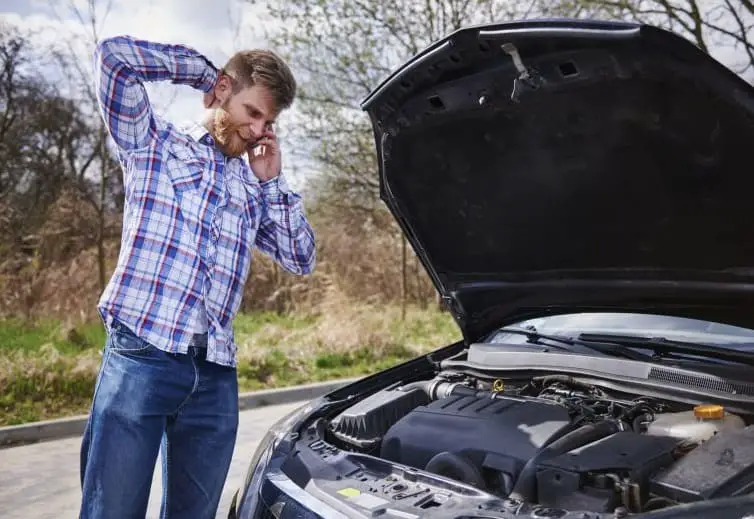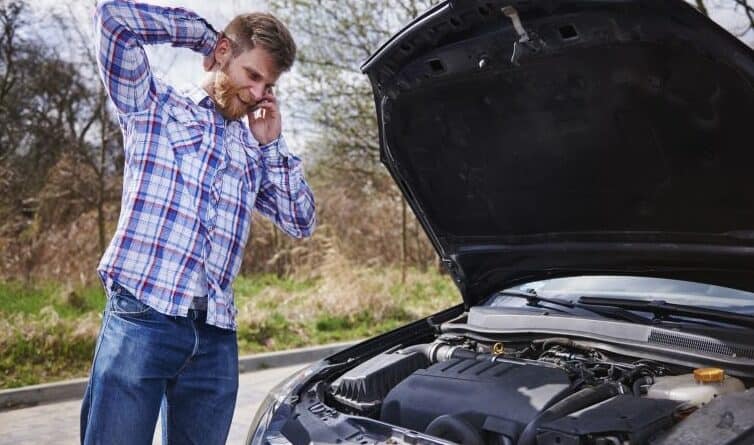What to do? Car Cranks but Won’t Start
Let me describe the worst nightmare of every car owner: You turn on the ignition, press the start button but car cranks but engine won’t start. Yes, your standard car breakdown scene from the movies.

Once you experience it yourself, it can be quite frustrating. Most will prefer their car key getting stuck in ignition instead of this because you know what’s wrong and how to fix it. But with the engine not starting, you’ll have to figure it out. And opening the bonnet and looking at the wonderful technology can be intimidating.
Worry not, let us give you few pointer to help you diagnose and fix the problem. If your car won’t turn over, either engine’s not getting the required air, fuel, or spark. These are the few things that you need to check:
Contents
Blown Ignition/Fuel System Fuse
Since cars these days are full of electronics and sensors, it’s best to start diagnosis with checking fuse box. Fuse box is mostly located under the bonnet. Look in the manual for fuse identification chart, it’s also available under the fuse box cover. Now inspect all fuses that are related to ignition system and fuel system.
Clogged fuel filter
Fuel filter sits between the fuel line and ensures that no contaminants enter the fuel pump or fuel injectors. Service life of fuel filters is quite long, say around 15,000 miles. However, service life can be shortened significantly if fuel quality around your area isn’t good. A failing fuel filter can give early warnings like reduced acceleration at higher rpms, misfiring, sluggish bottom end, etc. See all symptoms of bad fuel filter
In some cases using fuel system cleaner would also fix the problem. Or prevent the symptoms to show.
Worn out Fuel Pump
Fuel pump is placed after the fuel filter in the fuel line. Fuel pump have very tight tolerance and are lubricated by fuel itself. That’s why it’s not recommended to drive on low fuel. Once in a while is fine but some people don’t mind driving all the time in reserve fuel level.
Fuel pump can also be damaged if the pickup filter placed in fuel tank does not does its job properly. A dirty filter having difficulty flowing fuel can push out some gunk due to pressure buildup in fuel line. This gunk can enter fuel pump and start to clog it.
As you turn the key in ignition position, listen for the 2 second fuel priming sound. This is indication that fuel pump is working to build pressure in the fuel lines. If you don’t hear it then fuel pump is not working.
Before changing the fuel pump, check if fuel pump relay is good. You’ll find this in the fuse box area. Try swapping that and try to turn over the engine again.
A good mechanic can use a fuel rail meter and see if correct pressure it available in fuel line. If it’s fine then you can rule out any issue with fuel filter or pump. 7 symptoms of bad fuel pump
Weak Battery
Starting an engine demands lot of juice from the battery. But if you are starting your car after many days, battery might not provided the requires amps to the starter motor. Keep in mind a cold engine is slightly harder to cranks aswell.
Batteries also might not perform well in cold weather conditions. You can figure out if a weak battery is the culprit by hearing the cranking sound. If crank in not energetic as it usually is, or you get a click click sound from relay instead of starter motor then weak battery is the culprit. Learn what to do if car battery fails
Fouled spark plugs
Since most cars are multi-cylinder (Inline-4, V6, V8, etc), one bad spark plug will most likely cause misfiring. But if someone keeps ignoring this sign, other spark plugs will get fouled quikly. Then when engine is not getting proper spark, the engine may not start at all.
You need to unscrew each spark plug one by one and clean them up throttle body cleaner if you notice carbon deposit. Readjusting gaps will also help.
Faulty Ignition Coil
The spark plug may not be getting spark at all. This can be result of faulty ignition coil or any loose connector on it. Pull out connector from the ignition coil and spray some contact cleaner before reconnecting. If spark is still not going to spark plugs then the ignition coil could be faulty.
Faulty Starter Motor
Try tapping the starter motor body 2-3 times with a wheel nut spanner or some kind of stick. Often the start motor could freeze up due to corrosion or bad electrical contact. Tapping it might free it up and fix the starting problem.
Check 3 Sensors:
The car may refuse to idle with either of these sensor is having problem: Camshaft postion sensor, crank position sensor, Throttle position sensor. You should also see an engine warning light on the dash is it’s any of these sensor. But if you can access the connectors, quickly disconnect and clean it with contact cleaner before reconnecting.
It’s difficult to say what sensor is faulty without hooking up ECU scan tool. That’s why it’s good to have a basic ecu scan tool handy in your tool box. They are quite inexpensive these days and there’s no reason not to have one. But if you don’t any auto mechanic would surely have it.
Clogged Air Filter
The engine needs to breath freely to run properly. If the Air filter is dirty, it might not be the main culprit to engine not starting. But it will surely contribute to the problem. For example, if your spart plugs are bad, a dirty air filter will add to the problem. Cleaning the air filter could let you start the engine so you can drive to nearest mechanic.
If you drove through a flooded road, water could enter the air box and soak the air filter. I this case also the engine might die and not start. In such case you may need to replace the air filter. If you’re stuck on the roadside, just drive without airfilter to your nearest workshop.
Frozen Fuel due to low temperature
If you drive a diesel engine vehicle in cold temperature your might face starting issues. By low temperatures we mean below 32 degree fahrenhiet (0 degree celcius).
Freezing point of gasoline/petrol is -60 degree celcius/-76 degree fahrenhiet. So you don’t need to worry about this problem with gasoline powered car.
Diesel starts to become goey or jelly like as temperature reaches -5 degree celcius. That’s why it’s no longer able to flow easily. This causes engine starting issues. Keep in mind that the engine oil also becomes thick due to cold which adds to the problem with low oil pressure. It takes nearly 2-3 times more effort to start engine in sub-zero degree temperature.
You can prevent this problem to a certain extent by using anti gell fuel additives that drops the freezing point further. Also, keep your fuel tank full before parking your vehicle overnight in freezing cold weather.
Make sure you have glow plugs if you drive regularly in cold conditions. Glow plugs essentially heats up the combustion chamber before you crank the engine. Most newer trucks already come factory-fitted with glow plugs but confirm this about your vehicle.
Video Tutorial:
Tools and Products used in this video:
Battery Charger: https://amzn.to/3w84OqL
Fogging Oil: https://amzn.to/3fcRmuS
Spark Tester: https://amzn.to/2Q5nzeZ
Mechanic’s Stethoscope: https://amzn.to/3f65Psh
Compression Tester Kit: https://amzn.to/3vY4D0L
Also Read: Top 10 signs of failing transmission
- Cost of Changing Transmission Fluid - August 23, 2021
- 5 Symptoms of Blown Head Gasket - August 16, 2021
- 7 Symptoms of Bad Fuel Pump - August 11, 2021

